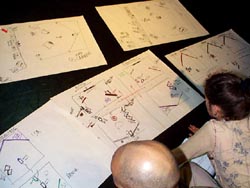Menu
Word/ Phrase Index
Cellbytes Home
Documentation Introduction
Streaming Rehearsals
Research Presentations
Video
Archive
|
-
|
Questions and Answers
As part of involving all the participants in the process of real time documentation, reflection and analysis a series of 21 questions were proposed to be answered. You will see these questions and answers appearing throughout these pages or click on the first word of the questions/ comments below to go directly there.
- provide a simple and clear explanation of how the Very Nervous System works, "differencing" and the concept of triggers.
- describe some aspect of your experience dancing in the two spaces.
- what is the difference between transmitting data and sending a video stream between the two spaces? Why is this difference interesting?
- there is apparently an 8 second lag in the image going one way between the two spaces. What sorts of strategies might you use to use the lag, draw attention to it, or try to nullify it.
- why might one prefer to hear gene's heartbeat in the other space rather than a simulation?
- describe your experience of working with the MAX or Image/ine interface in real time in co-operation with the other artists in the space - as you change those tiny parameters on the screen - what are you looking for? is it an intuitive process for you?
- what is MAX and what is MIDI - and how and why are we using these two technologies here in this project?
- what are some of the fundamental differences and/ or similarities between the experience of those on the stage and those behind the computers?
- what do you expect the audience to feel, get, understand, read or interpret from an event where triggers are setting off random elements in the program?
- explain what you mean when you say "I am multiplying by 1000 so I can get it out of a float and into an integer." What is the relevance of this 'action' for the performer and the audience?
- how have you felt at the end of each day?
- discuss a bit the varying degrees of 'disorientation' you have felt this week.
- write about the gap or lack of one you feel might exist between the dancers, choreographers, media or technical artists· and some of the reasons for this.
- write about a few of the compositional strategies you are using either as a choreographer or as a media/ technical artist. Are there differences between analog and digital strategies?
- What is Image/ine, what does it do, what is its relevance for live performance and what are the possibilities in the context of this project as different from other contexts?
- What do you imagine will make an interesting viewing experience for the web audience?
- Now that we are 5 full working days into this project - what can you say you have learned so far?
- Where do you see the issues of content and form evolving in the context of this project?
- As far back as the early 1960s, Joseph Svoboda and Merce Cunningham experimented with (respectively) live remote television streams in performance as well as triggering environments. What makes this work we are doing today new or not? Is there a particular set of aesthetics and / or compositional strategies that might be unique to this sort of artwork? Do you think this type of artwork or creative experience will become more common in the future and why?
- By now it is clear that there is a limited amount we can accomplish in this next week that we are together. What are the areas you think would be useful to explore further and why?
- YOUR OWN MINI-TOPIC OR QUESTION ·..
|
-
|
Images
 mapping media
mapping media
|


 mapping media
mapping media